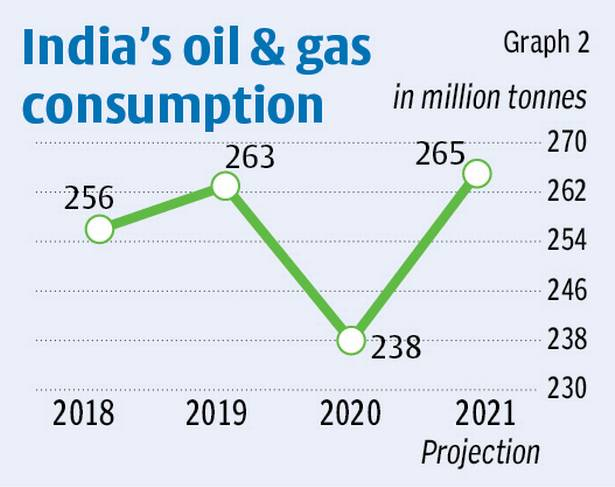Fossil Fuel And Policy Dilemma | 02 Aug 2021
This article is based on The agenda for Petroleum Minister Hardeep Singh Puri which was published in The Indian Express on 30/08/2021. It talks about the policy challenges faced by India with respect to crude oil import and utilisation.
The spread and speed of the destruction caused by climate change presents the Ministry of Petroleum and Natural Gas a policy dilemma, if not a moral one.
Dilemma is how to redefine the supply-side priorities in the face of the imperatives of Atma Nirbharta (self Sufficiency) when about 85% fossil fuels are still imported.
Thus, there is a need to look into various measures that can be taken by the ministry of Petroleum and Natural Gas in order to bridge the demand supply gap.
Issues Related to Crude Oil Management
- Balancing Environment With Extraction: Indian oil and gas industry leaders are faced with the twin challenge of responding to the changing environment, while sticking to the commitment of reduction of fossil fuel consumption.
- Import Dependent: The Indian economy is dependent on fossil fuels and there is no discernible end in sight to this dependence.
- India imports approximately 85% of its crude oil requirements and is exposed to the volatility of the international oil market.
- Moreover, a major chunk comes from the Middle East, predominantly Saudi Arabia, Iraq and Iran, which faces deep political and social fault lines and there is no knowing when our supply lines might get ruptured.
- Issues With Exploration: There have been few substantive commercial discoveries in recent years, in large part because the bulk of the reserves are in complex geological structures and harsh terrain (Himalayan foothills or deep waters offshore).
- They are difficult to find but even when found, the costs incurred are often so high that except in market conditions of high prices, the discovery is not commercially viable.
- Structural Challenges: In 2021 structural changes are brought by the Covid-19 pandemic. Some are mentioned in the Graph1.
Way Forward
- Rationalise Domestic Exploration: India should scale up the harnessing of its indigenous petroleum resources by intensifying exploration, but resources indulged in it should be properly managed.
- As the exploration has its own challenges, after rationalisation the resources earmarked for exploration can be deployed more productively elsewhere.
- Improving The Productivity And Efficiency: Companies such as ONGC should allocate increasing resources to improving the productivity of its producing fields. The average oil recovery rate in India is around 28%. That is, for every 100 molecules discovered, only 28 are monetised.
- The global average is around 45% for fields of comparable geology.
- The recovery rate may be better today but if there is still a wide gap, the application of Enhanced Oil Recovery (EOR) technology offers a relatively low-risk avenue for increasing domestic production.
- Need For a Contingency Plan: India currently has strategic reserves equivalent to 12 days of imports. The government has approved plans to increase this buffer to 25 days.
- By comparison, China, the EU, South Korea and Japan hold between 70-100 days of reserves.
- This should be done by constructing a cavern in Jamnagar, the entrepot that receives approximately 60% of our crude oil imports and is well connected through tanks and pipelines to the hinterland refineries.
- Restructure And Reorganise Public Sector Petroleum Companies: The upstream assets should be consolidated under ONGC (the upstream assets of BPCL, IOC, HPCL, and GAIL should pass onto ONGC) and GAIL should be changed into a public utility gas pipeline company.
- This restructuring will help cut back the “avoidable” costs of intra-public sector competition, reduce the inefficiencies of “sub scale” operations and provide a focused platform for balancing the shorter-term need to provide secure and affordable hydrocarbons with the medium and longer-term imperative of developing clean energy.
- Search For Alternatives: These companies should be encouraged to look beyond hydrocarbons to build an “Green energy” enterprise.
- Looking for other alternatives such as methanol based economy and biomass.
Conclusion
Thus, all stakeholders should not work through the siloed prism of oil and natural gas. They should broaden the aperture and become the progenitor of the energy transition.
The dilemma referred to in the opening sentence will be easier to resolve if priorities are developed within the framework of clean energy.
|
Drishti Mains Question There is an urgent need to look into various measures that can be taken by India in order to bridge the demand supply gap. Comment. |


